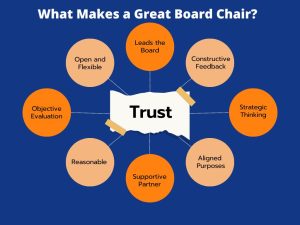
9 Answers to FAQ about the Board Chair and CEO Relationship
Nonprofit CEOs have a baked-in problem. The jobs come with instability by design. The CEO’s boss (the board of directors) changes regularly, as does the chair who leads the board.*
🔑 People leave bad bosses. You and your nonprofit benefit when you get your board chair partnership right. Moreover, this partnership can be a game changer. These FAQs will help you to create a partnership you’ll be sorry to see end.**
1. What is the role of the nonprofit board chair?
The board chair leads the nonprofit’s board of directors in coordination with the nonprofit executive. The partnership reduces the CEOs’ workload and provides the board with a peer to guide them.
2. Who makes a great board chair?
Individuals whose leadership focus is trust, not control.
Trust is challenging to define. It’s also what makes CEO-Chief Development Officer relationships work. Read Create a Remarkable CEO-Development Director Relationship to get introduced to my trust pyramid and some definitions.
3. What makes a great board chair?
CEOs cite these board chair behaviors:
- Aligns with the nonprofit’s purpose
- Supports the CEO—believes you’re in this together.
- Leads the board, so you don’t have to
- Gives constructive feedback, so you see better, understand, and can act
- Thinks strategically—because you’ve got the details
- Ensures an objective evaluation of your work and the boards
- Open, flexible, and reasonable. (In other words, they act like a healthy grown-ups.)
These behaviors in a board chair collectively generate trust, the foundation of a thriving partnership.
4. How often do your board chairs change?
CEOs report that chairs serve from one to two years. Of course, exceptions exist.
5. How engaged are chairs in committees?
Most chairs serve on the executive or governance committee.
6. What are the most frequently cited board chair-CEO best practices?
- Engage regularly
- Set ground rules
- Plan for Who Will Serve Next
For what happens when you don’t follow these practices, what getting it right looks like, and some innovative ideas to try, read 3 Board Chair Relationship Best Practices.
7. What does the CEO wish the board chair would do?
① Board Accountability
It’s awkward for the CEO to hold the board accountable since the CEO is responsible to them. Therefore, it’s best if the board chair reminds members to make their cash gift, talks about their obligation to attend meetings, and other shortcomings.
② Fundraising
Boards and chairs get fundraising wrong. It’s not about asking your friends for money. It’s about getting people in the funnel. Make your CEO happy by introducing them to new people. Make them cheer by challenging the board to follow suit.
③ CEO Evaluations
In most years, many, if not most nonprofit CEOs haven’t had a performance appraisal. Here is a post to get you started, 5 Performance Appraisals Executive Director & CEO Resources.
8. What three things should you remember when recruiting a board chair?
- Cut the Work Scope
Focus your board chair on what only they can do. Avoid overloading the position with tasks that others can and should do (for the sake of succession planning.)
- Figure out the “Career Path”
Great chairs know your organization on many levels. Often they attended multiple events and served on the fundraising, governance, and other committees. Figure out what chairs need to know and then guide people to these experiences, so you have options.
- Be a Known Quantity
Ease the transition and improve your recruitment by building relationships with prospects. People say yes when they know you are a reasonable, rational human.
Watch How to Get the Right Person to Be Board Chair for more.
9. How do CEOs approach Chairs when there are problems with the relationship?
As a trusted advisor, this is the most frequent of the FAQs client ask. The answer, of course, is it depends. Basically, you have three choices.
① Live with it
I once posted a countdown number in sight of my desk. Every day I reduced it. It was the most visible of the self-care actions I took waiting for a change.
② Plan your escape
Sometimes the current chair is challenging, and the next chair is worse. Update your resume and power through.
Now that we’ve covered accepting and escaping, consider a conversation.
③ Talk
Talking-about-it conversations are game changers that allow you to move to a new spot. For many, this is the riskiest option. It’s also the one with the most significant potential gain for you.
To prepare, use these resources:
- Video: How to Have a Difficult Conversation with Your Board Chair
- Book: Conversations Worth Having -how to tune in, frame, and ask questions that open up interactions.
And, by all means, don’t hesitate to reach out for a confidential chat. It doesn’t have to be lonely at the top.
—–
* Most positions come with bosses that stay, sometimes one’s whole career!
**Thanks to CEO-Chair Relationships Study participants and attendees at Karen’s Conversation, The Best CEO Chair Partnerships, for their insights and questions on board chairs in this post.
Karen Eber Davis is a nonprofit strategic planning consultant who works with visionary leaders committed to taking their organizations to new heights. She offers customized strategies, assessments, and coaching designed to help leaders lead their organizations to achieve their potential. She is the author of 7 Nonprofit Income Streams and Let's Raise Nonprofit Millions Together.
Categories
If you appreciate these Added Value posts, please consider subscribing.
Latest Posts
- How New Nonprofit CEOs Secure Board Buy-In for Strategic Planning
- How Nonprofit Leader Navigate Crisis with Clarity & Confidence
- One Way AI Can Help You Find a Path Where None Exists
- In Crisis? Resist Cutting Your Ability to Make Income
- Nonprofit Strategic Planning Assessment: 10 Questions to Strengthen Your Strategy

